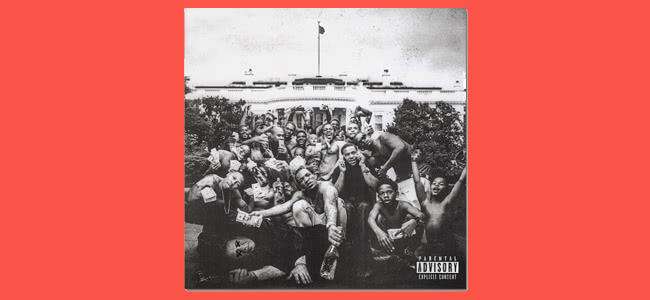Hip hop has enshrined the concept of the poet laureate within itself, creating a pedestal for an individual (or group) who is able to innovate and speak on behalf of the genre.
To become this, it requires a recognition from both mainstream and underground quarters of the subculture; an artist that has the ability to reach people and yet possess an unwavering artistic vision.
Former poet laureates include Nas, Tupac, Notorious B.I.G, Dre, Outkast; are all artists who had the ability to fulfil this relevant criteria of sales and artistic credibility. Recent history suggests despite detractors from the cheap seats, Kanye West has been rarely challenged since dislodging 50 Cent in arguably the last relevant sales battle (and shift in hip hop) in 2007.
Until now.
Kendrick Lamar’s third LP To Pimp a Butterfly is a disorienting, queasy, thick, sprawling, dense Artistic Statement (in capitals).
Whilst this record is very challenging and will rub many casual fans the wrong way, this complex panorama of jazz, funk, soul, hip hop and spoken word will enthral all those that challenge themselves to get lost in its labyrinth.
It’s clear early on that sonically, this is as ambitious as mainstream hip hop (and popular music) gets.
Lots of horns, effects, piano solos, guitar stabs, beats, basslines, guest vocals, screams, coos and melodies drift in and out, disappearing as soon as they originate. The soundscape is incredibly alien and abstract, loose and in the moment.
Kendrick vocally on the record is very forceful, regardless of how hard he’s tried to bury the meaning of his lyrics fifty-feet deep in a concrete mixture of philosophy, literature and pop culture. His mood shifts often; even changing his vocal pitch and taking on different voices, like he’s speaking for the many personalities that fight for control of his soul.
[include_post id=”440861″]
Here is where the key theme to the record lies – self-identity and the everyday battle to protect and control it.
Of course in the case of Lamar, its context is rooted strongly in the events involving race in the US over the last year. ‘King Kunta’ and ‘The Blacker the Berry’ tackle these issues head-on with their twin swagger and pulsating beats, staring down their white establishment oppressors with a cultural retaliation that potentially hasn’t been seen since Public Enemy.
Elsewhere, Kendrick’s whirlwind vision and endless imagination has him running into God in the form a homeless man at a gas station (‘How Much a Dollar Cost’), addressing the social order of the street (‘Hood Politics’) and how a lust for power via wealth and violence boxes in our everyday actions as people (‘Institutionalzied’).
There’s an array of other contexts Lamar views this battle for self-identity, through gender (‘These Walls’ and ‘Momma’), the twin states of mind involving euphoria and despair (‘i’ and ‘u’) and the concept of karma (‘Alright’).
The essence of the record is perfectly distilled in the final track ‘Mortal Man’, a song that ruminates on the responsibilities of fame that is thrust upon famous African Americans.
Kendrick uses a obscure 1994 interview with Tupac Shakur, and delivers a line in conversation with his long deceased idol which perfectly encapsulates the state of mind the record was made in:
“Sometimes I be like, get behind a mic and I don’t know what time of energy I’mma push out, or where it comes from. Trip me out sometimes”
‘Tupac’ replies: “Because the spirits, we ain’t really rappin’, we just letting our dead homies tell story for us”.
The ideal context of the record is the struggle faced by the modern African American, but there are many entry points for others to reflect on their own stories through To Pimp a Butterfly’s multi-faceted prism.
For some it might be too big picture and self-indulgent, and that’s understandable. This is a ‘What Does It All Mean’ piece of art; and there will be discoveries on its thousandth listen, let alone the ninth or tenth most of us are up to right now.
It’s still very cloudy, murky and ambiguous, but Lamar has left us a David Foster Wallace-esque document that attempts to challenge us on every level.
Whilst the concept of hip hop’s poet laureate is not a perfect one (women are still widely overlooked – someone like M.I.A and Missy Elliott deserve to be in the conversation), it’s an important touchstone to aim for. It fosters creative ambitions that seek not to play to a certain clique, but attempt to take radical ideas and force them upon the audience.
Lamar has done all of the above on To Pimp a Butterfly, and rightfully takes his place at the top.
But, as Dr. Dre reminds him in his Ghost of Hip Hop’s Past cameo on ‘Wesley’s Theory’, whispering like a bedside spectre in the night:
“But remember/anybody can get it/the hard part is keeping it motherfucker.”
To Pimp A Butterfly is out now via Universal




































